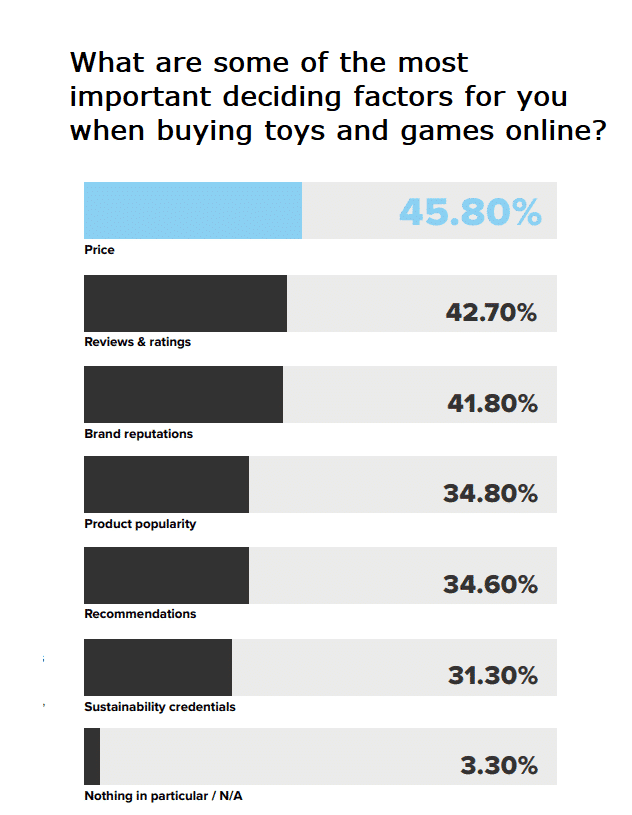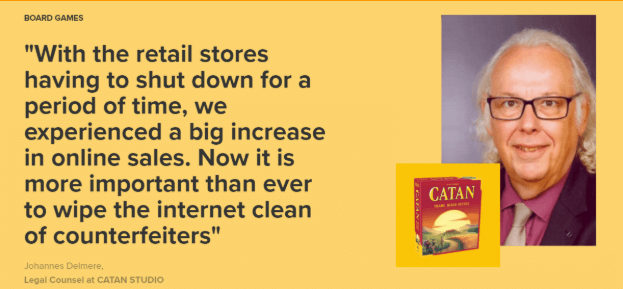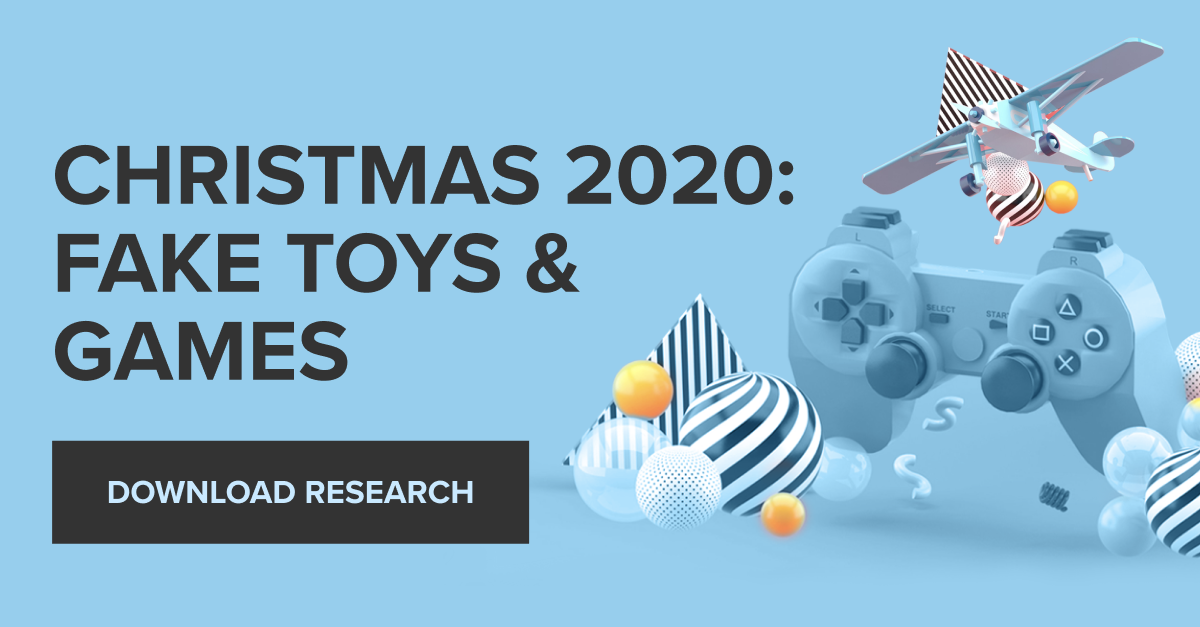
Table of Contents:
Last updated on: June 8, 2022
The counterfeit industry becomes all the more obscure when we consider how dangerous a counterfeit toy can be for a child at play. The damage that is done to young consumers can be irreversible.
In 2019, revenue generated from counterfeit toys reached $32.3 billion in the US and $44.6 billion in Europe. This year the numbers are showing no sign of slowing down, quite the opposite. Worldwide COVID-19 has forced shoppers to move to ecommerce. Additionally as many people are under increased financial pressure, many shoppers have become ever more deal-prone, making them vulnerable to bad actors. In fact our recent study shows that 52% of toy and game brands have seen an increase of counterfeits online.
Red Points carried out a market research on the toys and games industry to better understand the consumer perspective and purchasing habits ahead of the holiday season. This article outlines the most striking findings:
Counterfeiters are notorious for manufacturing goods that put consumers at risk. This is especially worrying when considering the idea of children coming into contact with fakes. The rules and regulations that hold authentic companies to a high standard of safety are completely ignored by counterfeiters.
The biggest red flag here are the toxic materials commonly found in counterfeit toys. Heavy materials such as lead and phthalates are putting young children in grave danger. Phthalates are known to cause irreversible damage to vital organs, as well as being directly linked to cancer, among many other risks. This is not common knowledge to consumers and it leads to inaccurate assumptions of how dangerous their choice may be when choosing to buy a fake for the right price.
Many unknown sellers online are in fact counterfeiters, despite appearing on legitimate search engines, social media platforms and online marketplaces. But, between the low barriers of entry to these websites and the ease of setting up convincingly accurate accounts, it can be extremely difficult for shoppers to know if what they see online will lead them to counterfeited products. Then, considering the huge discounts that the counterfeiters can offer, it’s no wonder so many consumers are willing to buy from unknown sellers. In fact, our study shows that it’s exactly those distracting factors that are dominating consumers’ decisions:

Another factor in the health and safety standards for toys is the size of objects, and how well they are assembled so as to not end up in the mouths of young children. An example of this is stuffed teddy bears. Each element needs to meet strict standards, which are rarely met by counterfeiters.
54,000 teddy bears were seized before the Christmas holidays, which showed major health hazards to young children. As a matter of fact, a concerning stat shows that 61% of parents can’t identify counterfeit online.
Consumers on ecommerce websites have so many options that it can become hard work sifting through the authentic from the plethora of counterfeit toys among the list. Fake reviews may now be common knowledge to most consumers, but making sure the seller is selling a genuine product is not yet as common. The safest option is to buy from the brand’s own website. Unfortunately, that wasn’t the most popular answer with our respondents: the vast majority(55.4%) of consumers are planning on buying toys and games products from marketplaces like Google, Amazon and eBay.
The dangers of counterfeit toys need to be continuously highlighted to consumers by brands. Consumers need to be aware that a discount without a thorough background search of the product’s provenance should not be considered at any cost.
A concerningly high number of consumers admitted to having purchased a counterfeit in the past year. Out of the one thousand participants that responded, 54% said they have purchased a counterfeit toy or game online, which is more than a double from last year.
There doesn’t seem to be any toys or games category that counterfeiters leave out. If we look at the most counterfeited product category, we can see one of the most dangerous counterfeit toys in the first place: Electronic toys. As previously mentioned, counterfeiters have no regard for health and safety. The risks of electrical toys can go as far as creating fires to electrocuting a young child. It may seem incomprehensible to many as to how these counterfeit electronic toys can be considered by consumers. The fact is that in appearance, they seem harmless and can even be perceived of good quality. Our data shows that 33% of respondents were satisfied with their counterfeit toy purchase.
What’s even more surprising: 49% of participants said the fake products exceeded their expectations. It may sit rather uncomfortably with many, but it proves that there isn’t enough information to consumers about the dangers of giving a child a counterfeit toy.
The efforts of customs officials are greater as each year goes by, but so is the number of counterfeits sold online. American-owned marketplaces are trusted by a vast majority of consumers, but there are only so many regulations they can put in place to protect online shoppers.
Unfortunately for legitimate companies, a knock-on effect has meant that genuine brands have also been burned with the results from these investigations. To consumers, seeing a brand’s counterfeits on marketplaces are a warning sign. Brands may be perceived as lacking control over their online presence, which results in consumers worried that they may fall into the counterfeit trap. In fact, 17% of respondents say they would no longer trust the brand if they ever bought fakes.
The sheer quantity of counterfeits on the most popular marketplaces is not easy for all to decipher, which leads to many consumers buying a counterfeit toy by mistake. For those that have felt that disappointment upon their package arriving, it can hit a bigger nerve than what other counterfeit products may provoke. It’s a ruined birthday or one fewer present under the Christmas tree for their children.
Consumers don’t want to take the risk of buying a counterfeit toy. Instead, they will opt for a different brand that seems to have little to no counterfeits online and feel more secure about their purchase. Our research shows that 35% of respondents think the original brands need to do more to protect consumers.
The negative impact on brands not addressing their counterfeit issue is clear, their brand image is put at risk and the negative publicity -although not directly related- of the damage these fake toys may do to young children can deeply damage a brand’s image.
Counterfeit toys manufacturers are a significant threat to toy brands’ revenues. Carefully-developed designs that have gone through rigorous product testing cannot hope to compete financially with counterfeited means of production that cost a fraction of the price. This in turn lowers the retail price of counterfeited goods, so profit margins can be significantly higher than those yielded by genuine products. 24% of participants said they would no longer purchase a brand’s products if they found that the brand had counterfeits.
Consumers are not always able to distinguish faulty products from genuine, with a study finding that under 4% of consumers on counterfeit sites actually intended to purchase a knockoff, so negative experiences are likely to be directed toward the original brand. They want a brand that is able to guarantee not only its own original products but to also guarantee that they won’t mistakenly buy a counterfeit toy either.
The rise of clone Lego brands reflects this, and the trend for Lego brand competitors to secure media affiliation licenses outside of Lego’s domain is exemplary of a further way in which counterfeit or clone products can have a negative impact on market success: by filling a gap in the market that could have been filled by the official brand.
So which brands are being targeted? Findings show that €1.4bn of EU revenue is lost annually due to counterfeiting, and the growing figure suggests that counterfeiters are becoming increasingly responsive to market demand. The ability of counterfeit toys manufacturers to roll-out products rapidly – thanks to exploitative production methods coupled with the opportunity to sidestep trading regulations – means that they can be concurrent with trends, as evidenced in the fast release of Rainbow Loom band knockoffs.
With the current global situation, the online counterfeit issue has witnessed a huge increase. Counterfeiters have become more aggressive since many brands are moving their offline business to online. This has made the need for technology to protect brands’ online revenue more important than ever.

The nature of counterfeit toys, particularly within the emerging ecommerce landscape, makes them difficult to tackle. The health and safety risks are uncomfortable knowledge to those that know. Brands dealing with grave issues of injuries from their brand’s counterfeits are faced with worrying consumers boycotting the brand completely. Once this has occurred, regaining consumer trust is next to impossible.
The solution lies in making consumers more aware of the risks involved with their apparent “good quality” counterfeit toys. Brands must help consumers to identify which is fake and which is authentic.
On a case-by-case basis, individuals can report spotted counterfeit products online, which will lead to their removal and – in certain cases – a ban of the seller in question.
On a more commercial scale, however, manual searching is extremely time-consuming. Whilst there are ongoing efforts to curb sales of counterfeit goods, loopholes continue to be exploited and safety standards continue to go unmet. In order to be effective on a large scale, a brand protection solution must be applied systematically, and it must constantly be adapted to new means of counterfeiting goods.
And lastly, the most important solution lies in using technology specifically designed to search the net for counterfeits in order to rid online marketplaces of these dangerous goods, both for consumers and for brands themselves.
